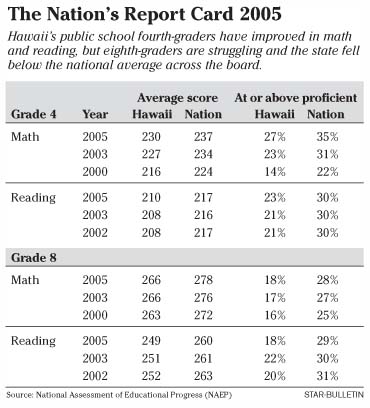Isle public schools test below average
Hawaii's public school students still rank near the bottom nationally in reading and math on "The Nation's Report Card 2005," despite improvements by fourth-graders here in both subjects, according to data released yesterday.
Just 18 percent of Hawaii's eighth-graders are rated proficient or advanced in reading and math, compared with roughly 28 percent of their U.S. peers, on this year's National Assessment of Educational Progress. Hawaii's eighth-grade test scores held steady in math but slipped in reading compared with 2003.
"We need to focus more on aligning middle school curriculum, instruction and assessment," schools Superintendent Patricia Hamamoto said.
Fourth-graders fared better. They improved their average reading test score to 210 this year from 208 in 2003, while the national score moved up a point to 217, on a scale of 500. That means 23 percent of Hawaii's fourth-graders are proficient in reading, up from 21 percent, compared with 30 percent nationally in both years.

Fourth-grade math scores for Hawaii climbed to 230 from 227, while the national average also improved three points to 237. That means 27 percent of Hawaii's fourth-graders are proficient or better in math today, up from 23 percent in 2003. Nationally, the figure is 35 percent today, up from 31 percent in 2003.
"We're pleased with the fourth-grade improvements," said Robert Hillier, state coordinator for the national assessment. "There's still a gap with the national in reading, but the gap keeps getting a little bit smaller each time."
But he expressed disappointment with the eighth-grade reading scores, which dropped two points to 249 this year compared with 2003. The national score slipped to 260 from 261.
"It parallels the national, but still, it's not the direction we want," Hillier said.
Math scores for Hawaii's eighth-graders held at 266 this year after improving since 2000. Nationally, eighth-graders scored an average of 278 in math, a two-point gain over 2003, continuing the upward trend.
The National Assessment of Educational Progress, mandated by Congress, is given to a representative sample of students in each state every two years. In comparing states with one another, it is important to note that overall averages do not take into account the different demographics of the state's populations, the report said.
Also, some states include more students who are likely to struggle on the test. Hawaii, for example, excluded just 3 percent of students from the test because they could not speak English or were in special education. Nationally, the average number of students excluded for those reasons was 7 percent.
Hawaii's performance puts it in the bottom tier of states. For example, Hawaii's fourth-grade average reading score was higher than California, Mississippi and the District of Columbia, and equivalent to Alabama, Alaska, Arizona, Louisiana, Nevada and New Mexico. Hawaii's average eighth-grade reading score, even after this year's drop, was higher than Alabama, Mississippi, New Mexico and the District of Columbia, and statistically equivalent to Arizona, California, Kentucky, Louisiana, Nevada, Tennessee and West Virginia.
Fourth-grade math average scores were higher than or statistically equal to 11 of the 52 states and jurisdictions, including the District of Columbia and the Department of Defense Schools. Eighth-grade math scores were statistically equal to four states and above the District of Columbia.
The tests are given in both public and private schools, but comparative results are released only for public schools because the number of private school students is too small for comparisons to be statistically valid.
The national assessment is a benchmark to gauge the rigor of each state's own tests, which are used to determine whether schools are performing up to par under the federal No Child Left Behind Act. The performance of Hawaii's students on the national test parallels their scores on the Hawaii State Assessment.
Girls did substantially better than boys on the reading tests nationally and locally. In math, scores were similar for both genders, with males a point or two ahead of females nationally, and females a point or two ahead of males in Hawaii.
The national tests provide average scores and also rate students as "below basic," "basic," "proficient," or advanced" in the subject matter. About 658,000 students nationwide took the 2005 assessment in math or reading.

